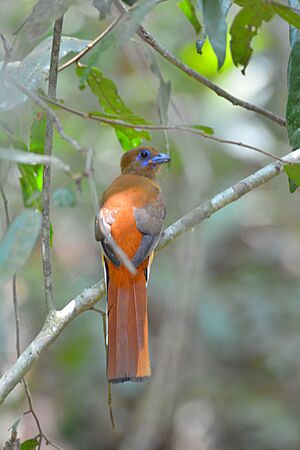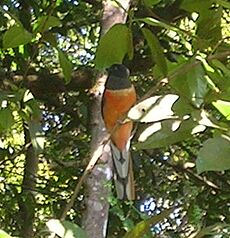Malabar trogon facts for kids
Quick facts for kids Malabar trogon |
|
|---|---|
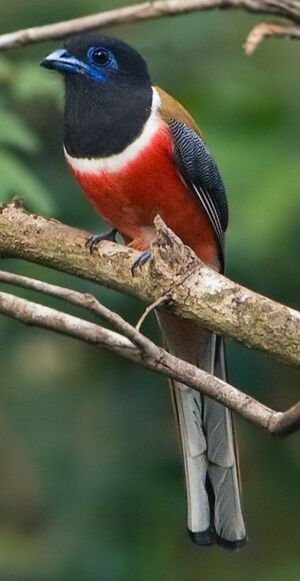 |
|
| Male H. f. malabaricus | |
| Conservation status | |
| Scientific classification | |
| Genus: |
Harpactes
|
| Species: |
fasciatus
|
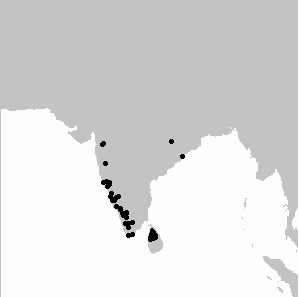 |
|
| Synonyms | |
|
Harpactes malabaricus |
|
The Malabar trogon (Harpactes fasciatus) is a beautiful bird that belongs to the trogon family. You can find these colorful birds living in the forests of India and Sri Lanka. In India, they mostly live in the Western Ghats, the hill forests of central India, and parts of the Eastern Ghats.
Malabar trogons mainly eat insects. They don't migrate far, but they might move to different areas during rainy seasons in the hill forests. Like other trogons, male and female Malabar trogons look different. They make soft, gurgling calls that are hard to hear unless you are very close. These birds often sit very still on branches under the forest trees, facing away from you. This makes them tricky to spot, even with their bright colors!
Contents
What Do Malabar Trogons Look Like?
Like most trogons, these birds are very brightly colored. The males and females look different, which is called sexual dimorphism.
The male Malabar trogon has a dark, slaty-black head and chest. A white stripe separates this black area from the bright crimson (red) color on its belly. Its back is olive-brown to chestnut. Its wings are black with tiny white wavy lines.
The female Malabar trogon is different. She doesn't have the strong black and crimson colors. Her head and chest are a bit darker than her back, which is olive-brown. The bright crimson on the male's belly is replaced by a yellowish-orange color on the female.
Both male and female Malabar trogons have a bluish beak and blue skin around their eyes. Their eyes are dark brown, and their feet are pale bluish. Their nostrils are covered by small feathery tufts.
A unique thing about trogons is their feet! They have a special foot shape called heterodactyl. This means two toes point backward and two toes point forward. Most birds have three toes pointing forward and one pointing backward.
Some groups of Malabar trogons have slight differences. For example, the birds in Sri Lanka are a bit smaller and have brighter colors on their upper bodies.
How Malabar Trogons Behave and Live
These birds often perch very still, especially if they feel scared. Sometimes, they even cling sideways to branches. When they call, they might raise and lower their tail. Their call sounds like a series of soft, purring notes. The male's song is a series of sharp kyau calls.
The breeding season in India is usually from February to May, before the heavy Monsoon rains. In Sri Lanka, it's from March to June.
When they sit still, they look a bit hunched. In Hindi, hunters call them kafni churi, which means they look like they are wearing a fakir's (a holy person's) robe because of their hunched, neckless look. In Kerala, they are called theekakka, which means "fire-crow" because of their bright colors.
What Do They Eat?
Malabar trogons eat only insects. Unlike some other trogons, they don't seem to eat fruits. However, some studies have found seeds in the diet of Malabar trogons in Sri Lanka.
In Sri Lankan forests, they often join mixed-species foraging flocks. This means they hunt for food with other types of birds. Sometimes, other birds like drongos might try to steal food from them, which is called kleptoparasitism.
A study in Kerala found that Malabar trogons usually look for food between 5 and 10 meters high in the trees. Females often look for food lower down. When they hunt on tree bark, they use their tail to prop themselves up, just like woodpeckers do. They especially like to search on old, decaying tree stumps. They sometimes go down to the ground to find insects under fallen leaves. They might also fly and try to scare out prey, then hover to pick it up. They can even hang upside down to reach insects on vertical tree surfaces! Before eating their prey or feeding it to their young, they often mash it or hit it against a branch.
Calls and Flight
Their contact call is a series of about five soft que notes. These calls become louder during fights over territory. Their alarm call is a churrrr, and they make a similar sound before they go to sleep for the night. Even though they can fly fast, they don't like to fly very much. In the Nilgiri hills, they move to higher places only during the summer.
Nesting and Reproduction
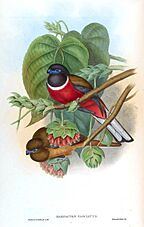
Malabar trogons make their nests in rotting trees or stumps. These are easy for them to carve out using their strong beaks. Both the male and female take turns digging out the nest. It can take about a month to finish the nest. The bottom of the nest is just made of wood dust; they don't add any extra lining.
A study in Kerala found that they usually lay two eggs, though older reports suggested three eggs. The eggs are laid two days apart. Both parents incubate the eggs, but the female usually sits on them at night. The eggs hatch after about 19 days.
When the chicks first hatch, they are mainly fed caterpillars. Later, they get bugs, flies, and grasshoppers. The parents don't clean the nest; they leave the nestlings' waste inside. The adult birds continue to feed their young for about 5 to 6 months after they leave the nest. They stay with the same partner for more than one breeding season.
Birds in Sri Lanka have been seen diving into water from a branch to bathe.
Status of the Malabar Trogon
The Malabar trogon is becoming rarer in many parts of India. Scientists think they are sensitive to forests being broken up into smaller pieces. A famous bird expert, Salim Ali, once said they were common in some areas where they are now rare.



